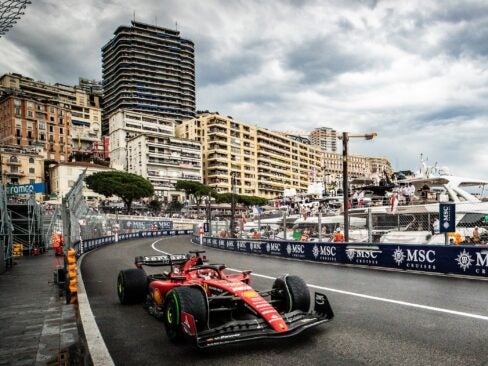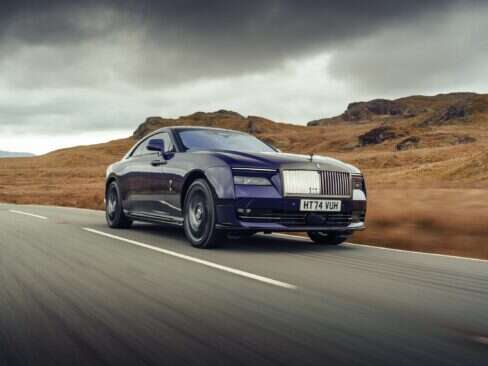We thought the latter would be more fun. Having developed race cars for over 70 years, Ferrari knows a thing or two about flinging the needle around a speedometer. A unique blend of power, minimal weight, aerodynamics and gearing has put Ferrari at the forefront of automotive engineering. Add to this a lot of R&D money and a boyish glee in fast things, and you have a recipe for some serious velocity.

When you’re talking about the fastest Ferraris ever built, you’re either talking about street legal cars (very fast), or cars built for the race track (very fast indeed).
One downside of such jaw-dropping speed is the effects of crashing. In March 2012, Ling Gu, the son of a Chinese government minister, totalled his Ferrari 458 Spider, killing himself and seriously injuring his two female passengers. Both driver and passengers were found semi-naked—a cautionary tale for anyone partial to high speed sex games. Ling Gu was the son of Ling Jihua, a long-time aide to Chinese President Hu Jintao. Ling Jihua was promptly dispatched from Hu’s government.
Another Ferrari-owner in Japan had a luckier escape after speeding. The doctor from Okama was hit with a hefty fine after police saw footage of his car doing 77mph in a 25mph zone. This wasn’t caught on speed camera—the video was shot from inside the car by the driver himself. The culprit posted the video on YouTube because he “wanted people to understand the beauty of a Ferrari”. Viewers who didn’t appreciate the gesture reported the video to the police, who launched an investigation. The man was convicted based on the distance covered in the time shown.
Ferrari began its life in 1928 in Maranello, northern Italy, when Enzo Ferrari founded a company to sponsor racing drivers. Under the name Scuderia Ferrari—translating loosely as “Team Ferrari”—the company sponsored amateur drivers in Modena, who drove Alpha Romeos at that stage. Enzo Ferrari was soon hired by Alpha Romeo to lead their motor racing department. In 1940, Scuderia Ferrari produced its first race car, the Tipo 815, which debuted at the Mille Miglia. The rest is history.
So, without further ado, the 15 fastest Ferraris ever to grace a race track…
Ferrari Enzo ZXX Evolution Edo Competition

Top speed: 245 mph
0-60 mph: 3.1 seconds
The fastest Ferrari to tear up a track is another modification by Edo Competition, a very different beast to the original Enzo that left the Maranello factory.
The Enzo ZXX Evolution is a one-off that was once the Enzo XX Evolution, until owner Zahir Rana crashed it into the sea at the 2011 Targa Newfoundland. Rana was unhurt but the water-logged car needed a minor miracle to recover. Fortunately, Edo Competition does miracles rather well, and after some serious tinkering, returned to Rana the almighty Enzo ZXX Evolution.
Edo Competition stripped the car down to the bare monocoque and replaced all the wiring and parts that were starting to corrode. The wheels, nose and rear bumper were replaced, and revised stripe and lettering treatment were added over the yellow paint. The roof scoop and Ferrari FXX style rear wings and high-mounted exhaust outlets were retained. Already producing 850hp before the crash, the new ZXX now makes a blistering 950hp, and pushes the speedo to 245mph. Not for the faint-hearted.
Ferrari Enzo XX Evolution Edo Competition

Top speed: 242mph
0-60 mph: 3.2 seconds
When it comes to vital stats, the Ferrari Enzo XX Evolution Edo Competition accelerates 0-60 mph in 3.2 seconds, and reaches 200mph in only 19 seconds.
Gear shift is 60 milliseconds, compared to 40 milliseconds on a Formula One car. With a 6-liter 12 cylinder mid-engine berlinetta, this is a rare breed on the tuning market. Several aftermarket parts upgraded the original Enzo XX Evolution to the Edo Competition category, with displacement increased from 6 to 6.3 liters. The Edo Competition also benefitted from new camshafts, connecting rods, titanium valve spring retainers, and modified cylinder heads to cater for the displacement increase.
Other new features with the Edo Competition included high flow catalytic converters, high performance exhaust headers and a muffler. Remote control butterfly values allow the driver to switch between two different exhaust sounds. The 12-cylinder Enzo XX Evolution revs 9,600 rpm thanks to the solid tappets that replaced the stock hydraulic tappets of the Enzo. The Edo Competition weighed in 220 lbs (100 kg) lighter than the Ferrari Enzo and produced 840 horsepower.
In 2011, owner of ZR Auto car dealership, Zahir Rana, crashed his Enzo XX Evolution into the sea at Targa Newfoundland. Thankfully he escaped with only his pride bruised, but the saltwater wreaked havoc with the car. Rana had the last laugh when Edo Competition finished the repairs and returned a car to surpass the original…
Ferrari FXX Evolution

Top speed: 240 mph
0-60 mph: 2.5 seconds
A rare breed of Ferrari, only three of these cars were ever made. The FXX Evoluzione has a 6.3-liter, V12 engine with a displacement of 6,262cc.
With a top speed of 249mph, it was intended only for the Ferrari Client Test Driver program. As the name suggests, the Evoluzione was a development of the Ferrari FXX. The 6.3-liter V-12 engine now produces 860 horsepower at 9,500 rpm—1,000 rpm higher than the original FXX. Cog-swapping is 60 ms—compared to 80 ms for the original FXX gearbox—and new gear ratios have been optimized for the new state of engine tune. Ferrari have not released performance figures, but we’re looking at 0-60 mph in well under four seconds.
A new traction-control system allows the driver on-the-fly adjustment, with nine different settings controlled by a switch on the center console. The system was designed to be more responsive to individual driving style allowing the car to adapt to the driver rather than vice versa. Combined with new front suspension geometry, the refined traction-control system also reduces tire wear, while the Brembo brakes and Composite Ceramic Material discs have also been redesigned to double pad life. On the body, the FXX Evoluzione features a new rear diffuser and rear flaps, increasing rear downforce and aerodynamic efficiency by 25%.
Ferrari F50 GT

Top speed: 235 mph
0-60 mph: 2.9 seconds
Also known as the Ferrari F50 GT1, the Ferrari F50 GT was a development of Ferrari F50, for use in the BPR Global GT Series.
Dallara collaborated on the project, which marked Ferrari’s golden anniversary. When homologation-specials like the Porsche 911 GT1 in the BPR entered the scene, Ferrari chose not to put the F50 GT into production. Only three cars were sold to the public—the prototype and two made especially for private buyers.
The focus of the F50 GT was motor sports engineering rather than passenger comfort. The rigid structure featured a solid mounted chassis, with little rubber in the suspension, and lacked front, rear or engine subframes. The engine and transmission was attached directly to the central tub, providing the rear support structure and holding the rear suspension components. The Ferrari F50 GT meets homologation requirements, with good aerodynamics and braking. Ferrari looked to Micholelotti to develop the F50 body, after their previous collaboration on the F40 GT and the 333 SP prototype racers.
Ferrari 288 GTO Evoluzione

Top speed: 230 mph
0-60 mph: 4.1 seconds
A development of the Ferrari 288 GTO, the 288 GTO Evoluzione packed a punch with more power and a more aggressive design.
The engine in the 288 GTO Evoluzione produced 650 hp (480 kW), and with weight of 940 kg (2,072 lb), the car could hit a top speed of 225 mph (362 km/h). Only five were built and all five are still alive and well, with one on display in the engine manufacturing facility in Maranello.
The Ferrari 288 GTO Evoluzione shows a visual progression from the 288 GTO to the series of super cars that followed: the F40, F50 and Enzo. The experimental 288 GTO model was planned as the Group B competition version of the 288. They ultimately became mobile test beds for the technology used later in the F40. The steel tubes and composite reinforcements were kept from the chassis structure of the 288. The first engine in an Evoluzione was a Tipo F114 CR, with the turbo pressure set at 1.4 bar (compared to 0.8 bar for road car).
Ferrari FXX

Top speed: 230 mph
0-60 mph: 2.6 seconds
Based on the street-legal Enzo, the Ferrari FXX appeared in 2005 as part of a program allowing drivers use of the car on Ferrari-approved tracks.
With an engine modelled on the Enzo’s, the displacement has been boosted from 5,988 cc to 6,262 cc. Output increased from the Enzo’s 660 PS to 800 PS at 8,500 rpm. The gearbox made use of Ferrari’s F1 program, with a shift time of under 100 milliseconds.
The FXX’s engine is based on Enzo’s, but displacement has been increased to (6.3 L; 382.1 cu in) from (6.0 L; 365.4 cu in). The carbon fiber-reinforced silicon carbide (C/SiC) ceramic composite discs were kept from the Enzo, while the tires are custom-developed 19-inch slicks. The FXX offers data-monitoring and telemetry that allows the driver to improve performance while providing Ferrari technicians with data to refine the FXX and future road-going models.
Ferrari built 30 of the FXX model, with 29 cars going to pre-selected buyers and one presented to Michael Schumacher when he retired from Formula One at the end of 2006.
Ferrari F40 LM

Top speed: 229 mph
0-60 mph: 3.1 seconds
The ‘LM’ stands for LeMans, a tag added to the already exclusive F40 built for Ferrari’s hand-picked clients.
Michelotto of Padova oversaw the F40’s development, which included a reinforced chassis, more aggressive bodywork with a deeper front air dam and larger rear wing. Intended for racing, the new model also featured an adjustable cockpit, a racing interior, stiffer suspension, up-rated brakes, competition gearbox, wider wheels and an engine producing between 850-900bhp. Only 17 factory F40 LMs were originally built.
Ferrari F430 Scuderia Novitec Rosso 747 Edition

Top speed: 218 mph
0-60 mph: 3.4 seconds
A tribute to the Ferrari 430 Scuderia, the Novitec Rosso’s Edizione 747 made the best of the new bi-compressor which puts the power at a fearsome 747hp.
Torque has also been lifted to 738Nm at 6,300rpm. 0 – 200 mph takes 22.9 seconds. The intercooling system features a dedicated water circuit with a maximum boost pressure figure of 0.53 bar. Novitec Rosso comes in a two-tone special matte yellow and grey coat, which can be matched to the interior on request. Wheels are size 8.5Jx20 at the front and 12Jx20 at the back. Matching Michelin Pilot Cup sport tyres measure 245/30 ZR 20 and 315/25 ZR 20 respectively. The front suspension can be lifted by 40mm for easy parking access. The interior features a flat-bottomed leather and carbon fiber steering wheel and carbon fibre shift paddles.
Ferrari Enzo

Top speed: 217 mph
0-60 mph: 3.65 seconds
Named after the Ferrari founder, this 2011 edition is a revival of the original 2002 Ferrari Enzo, with a lightweight carbon-fiber body and V12 engine producing a maximum power of 660bhp.
One of the ten fastest street legal cars in the world, the Ferrari Enzo 2011 has a top speed of 217mph and can reach 60mph in 3.4 seconds.
With only 400 units produced, the cost of the 2011 Enzo goes up every time one of them crashes, which happened most publically at the 2011 Targa Newfoundland. Behind the wheel was Zahir Rana, owner of ZR Auto car dealership, who had modified the car in Germany to produce a staggering 850 horsepower and achieve 0-60 mph in 2.8 seconds. The result? Rana took a corner wrong and ended up landing his favorite toy in the sea. Thankfully he escaped with only his pride bruised.
Ferrari Enzo Gemballa MIG-U1

Top speed: 217 mph
0-60 mph: 3.5 seconds
Uwe Gemballa is better known for refining Porsche cars—a role he has perfected over the past 30 years.
With the Ferrari Enzo Gemballa MIG-U1, Gemballa turned his skills to Ferrari and re-engineered the famous Enzo. Produced in a limited run of 25 cars, the reinvention comprised new aerodynamics and real carbon components to combine the lowest weight with the highest material strength. The front spoiler lip generates downthrust of up to 35 kilograms at the front axle. The flap on the newly designed rear spoiler generates even up to 85 kilograms more downthrust on the rear wheels. For the best handling results, the flap lowers, as soon as the car reaches a speed of 75 mph.
The GEMBALLA car body components therefore guarantee the functionality of the new super sports car and provide the car with a unique look at the same time. Following the design of Formula One racing cars, the GEMBALLA MIG-U1 has an extended front and an edged rear spoiler. Formerly rounded edges were replaced in order to provide the car with an aggressive look with wide air inlets and outlets.
Ferrari 599 Novitec Rosso RACE 848

Top speed: 214 mph
0-60mph: 3.4 seconds
Novitec Rosso produced just three of these cars, modified from the Ferrari 599 GTB and more powerful than the previous Ferrari 599 Fiorano.
The most significant differences can be seen in the styling—the 848 RACE version features a new front spoiler lip, rear apron, rear diffuser, custom rear wing and new rocker panels. These upgrades were installed to improve aerodynamics and cooling to the V12, which received some aftermarket parts.
The tuners hooked up the 6-liter V12 engine with a twin compressor system, new intake manifold, injectors, air filter, and ECU tuning. Performance numbers for the Ferrari 599 show an output of 837 hp at 7,900 rpm, and 842 Nm of torque at 6,300 rpm.
Ferrari 599 Novitec Rosso Bi-Compressor V12

Top speed: 213 mph
0-60 mph: 3.5 seconds
This Notivec twin-supercharger delivers up to 800 bhp. High-flow injectors combine with two belt-driven Rotex superchargers, a carbon fiber airbox, new exhaust headers and an adjusted ECU.
Novitec offers 5.7 psi and 11.2 compression ratio, with 30% more power from the standard type F140C V12.
An adjustable KW system replaced the magnetorheological dampers. The new Notivec NF3 wheels house the 16 inch Brembro unit brakes and 1.6 inch lifters raise the front end. Other highlights include a Rosso Supersport steering wheel, new aluminum pedals and longer shifter paddles. The body is available with a front splitter, new sills and a diffuser in either fiberglass or carbon fiber. Highlights of the tuning include an aerodynamic-enhancement kit refined through wind tunnel testing, three-piece 21-inch wheels with high-performance Pirelli tires and calibrated sports suspension.
Ferrari 599 GTO Novitec Rosso

Top speed: 211 mph
0-60 mph: 3.2 seconds
Just when you thought the Ferrari 599 GTO couldn’t be surpassed, Novitec Rosso came along and created a beast with a phenomenal 900hp.
Having previously masterminded the tuning of the Ferrari 458 Italia and the Race 606 Carbon Ferrari California, Novitec Rosso know a thing or two about a Ferrari’s capabilities. The 599 GTO Novitec Rosso has kept the aerodynamics of the original, and from the outside looks similar to the what came before. The difference is in the engine. And what a difference.
As well as a monumental power increase, the 6-Liter V12 engine was given a maximum torque of 636 lb-ft, while the original 599 GTO made do with a mere 661hp and 457 lb-ft of torque. Other new features include a modified intake manifold, larger fuel injectors, new high-flow air filters, a new intercooler and stainless-steel sport exhaust system with 90 mm tailpipes.
Ferrari 599 GTB Fiorano Mansory Stallone

Top speed: 211 mph
0-60mph: 3.4 seconds
Mansory is no stranger to customising fine cars, with a list of clients that includes Aston Martin, Bentley and Rolls-Royce.
With the Ferrari 599 GTB Fiorano Mansory Stallone, Mansory has added a very eye-catching feather to its cap. Improving the Ferrari 599 GTB Fiorano was no mean feat, but Mansory have succeeded in a making some stunning leaps in both luxury and performance. The carbon body ensures weight is kept to a minimum, and the ostrich leather interior is the height of elegance.
The performance kit includes high-performance compressors and custom made intercooling. The supercharging of the V12 power train is supported by a sport air filter with higher air throughput as well as modified control electronics. This increases the performance of the large 6-liter twelve cylinder engine from 620 to 720hp. The torque increased by an additional 92 Nm. The sound of the stainless steel sport rear muffler complements the car’s sporty appearance.
Ferrari 599 SA Aperta Novitec Rosso

Top speed: 211 mph
0-60 mph: 3.1 seconds
Only 80 of these cars were built in a one-time limited-edition production run from tuning legend Novitec Rosso.
A twin-supercharger conversion increases the V12 power output from standard 670 to 888hp and puts peak torque at 636 lb/ft. The unique power yield makes the Ferrari 599 SA Aperta Novitec Rosso one of the most powerful drop-top sports cars in the world.
Other outstanding features include sport springs, lightweight Novitec Rosso forged wheels in a staggered combination with diameters of 21 and 22 inches, and a stainless-steel high-performance exhaust system with butterfly valve. Driven by a cogged-belt system, the bi-compressor engine is lubricated by a dedicated oil circuit and includes a large water-to-air intercooler with dedicated water circuit. Exhaust manifolds are calibrated specifically to the bi-compressor engine, and the stainless-steel exhaust system comprises four black-coated tailpipes with a diameter of 90mm each. The exhaust note can be changed by pushing the ‘Manettino’ button on the steering wheel.









